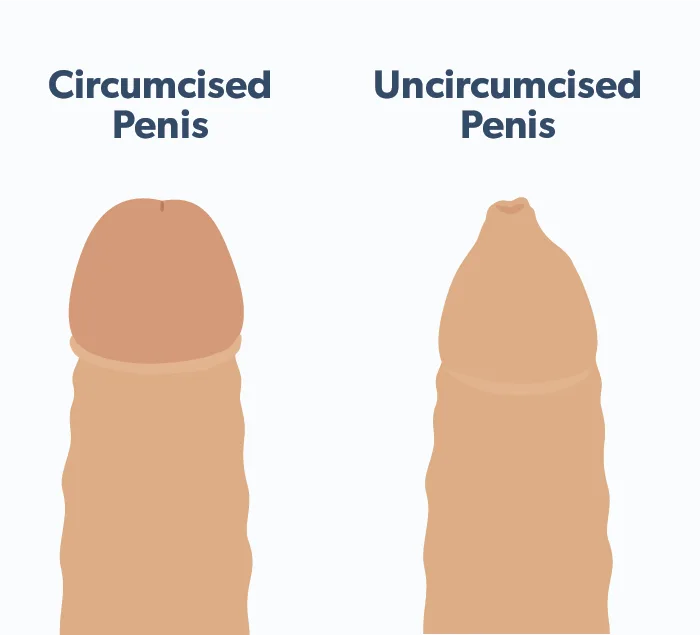Here's what we'll cover
Here's what we'll cover
Circumcision is probably one of the most controversial topics a new parent of a baby with a penis will face. While this article can’t help inform that decision, it will discuss circumcised vs. uncircumcised penises—what’s the difference, how it may affect your sex life, and how it impacts a person’s health.
What is circumcision?
Circumcision is the surgical removal of the foreskin, the tissue that covers the head of the penis (a.k.a. glans). It's usually performed a day or two after birth (with some notable exceptions, such as in Judaism, when it's performed on day eight). Circumcision may be performed on an adult to relieve a condition called phimosis, in which the foreskin becomes painfully tight and non-retractable (Siev, 2016).
A circumcised penis is casually referred to as "cut," while "uncut" is slang for an uncircumcised penis.
Male circumcision is still very common in the United States, but circumcision rates have slightly declined over the first decade of the 21st century. In 2000, 61.3% of male babies were circumcised soon after birth in the U.S.; that number fell to 56.9% in 2010 (Warner, 2015). Circumcision is often part of religious and cultural traditions. As a religious ritual, circumcision dates back centuries, particularly in Jewish and Islamic communities.
What does an uncircumcised penis look like?
There are differences in appearance when it comes to uncircumcised vs. circumcised penises.
A circumcised penis has an exposed glans, while the foreskin covers the glans and may hang down past an uncircumcised penis. The length of the foreskin of an uncut penis can differ. Some men may have longer foreskins, while others may cover the tip of the penis only partially.

The foreskin doesn't add size to the penis, in terms of what we think about when we talk about penis size. Say you had a foreskin but were circumcised in adulthood; the size of your erection wouldn't be any smaller. That's because the foreskin often retracts during an erection. There isn't a size difference in the flaccid state, either. The foreskin may add the appearance of a little bulk, but the foreskin is a thin layer of tissue, so the size differential isn't significant (Warees, 2021).
Does circumcision affect your sex life?
Some opponents of circumcision claim it reduces sexual pleasure. The theory is that the foreskin protects the glans from rubbing against clothing and becoming desensitized. The science doesn't conclusively bear that out.
A 2013 Belgian study found that circumcision reduced penile sensitivity and required greater effort to achieve orgasm (Bronselaer, 2013). However, more studies have found the vast majority of circumcised men are satisfied with their sex life. A 2016 Canadian study tested the penile sensitivity of 62 men, half of whom were circumcised and half who weren't. Researchers found the two groups had no difference in sensitivity (Bossio, 2016). And a large review of 36 studies found that circumcision didn’t lead to decreased sexual arousal, sensitivity, or satisfaction (Morris, 2016).
Circumcision doesn’t affect fertility. There's no evidence that circumcision has any effect on sperm production.
Circumcised vs. uncircumcised: are there health benefits?
It's a bit easier to keep a circumcised penis clean. The foreskin naturally develops smegma, a combination of oils and dead skin cells. Care of the uncircumcised penis involves retracting the foreskin while bathing, to clean underneath and prevent secretions from building up. If this isn’t done regularly and correctly, infants and adults can develop an infection called balanitis, in which the glans of the penis becomes inflamed.
Some studies have found that uncircumcised men might have a higher risk of a very rare form of penile cancer called “squamous cell carcinoma” of the penis. But the data is inconclusive, and in the U.S., the risk of penile cancer is very low even among uncircumcised men. The American Cancer Society notes that after eliminating risk factors like smegma buildup and phimosis, those studies don't actually show circumcision has a protective effect (ACS, 2021).
Besides lowering the risk of contracting HIV in heterosexual men, circumcision has been shown to lower a man's risk of getting genital herpes (HSV-2) by 28% and HPV (human papillomavirus) by 35% (Tobian, 2009).
Other studies have shown that women with uncircumcised partners are more likely to acquire HPV (which causes most cases of cervical cancer), which might explain why cervical cancer is lower in the sexual partners of circumcised men (Albero, 2012; Hernandez, 2010).
Circumcision does not protect against infection from gonorrhea, chlamydia, or syphilis.
DISCLAIMER
If you have any medical questions or concerns, please talk to your healthcare provider. The articles on Health Guide are underpinned by peer-reviewed research and information drawn from medical societies and governmental agencies. However, they are not a substitute for professional medical advice, diagnosis, or treatment.
Albero, G., Castellsagué, X., Giuliano, A. R., & Bosch, F. X. (2012). Male circumcision and genital human papillomavirus: a systematic review and meta-analysis. Sexually Transmitted Diseases, 39 (2), 104–113. doi: 10.1097/OLQ.0b013e3182387abd. Retrieved from https://pubmed.ncbi.nlm.nih.gov/22249298/
Bossio, J. A., Pukall, C. F., & Steele, S. S. (2016). Examining Penile Sensitivity in Neonatally Circumcised and Intact Men Using Quantitative Sensory Testing. The Journal of Urology, 195 (6), 1848–1853. doi: 10.1016/j.juro.2015.12.080. Retrieved from https://pubmed.ncbi.nlm.nih.gov/26724395/
Bronselaer, G. A., Schober, J. M., Meyer-Bahlburg, H. F. L., T'Sjoen, G., Vlietinck, R., & Hoebeke, P. B. (2013, May). Male circumcision decreases penile sensitivity as measured in a large cohort. BJU International, 111 (5), 820–827. doi: 10.1111/j.1464-410X.2012.11761.x. Retrieved from https://www.ncbi.nlm.nih.gov/pubmed/23374102
Can Penile Cancer Be Prevented? (n.d.). Retrieved from https://www.cancer.org/cancer/penile-cancer/causes-risks-prevention/prevention.html
Does Circumcision Hurt Sexual Pleasure? Study Draws Fire. (n.d.). Retrieved from https://www.livescience.com/27769-does-circumcision-reduce-sexual-pleasure.html
Hernandez, B. Y., Shvetsov, Y. B., Goodman, M. T., Wilkens, L. R., Thompson, P., Zhu, X., & Ning, L. (2010). Reduced clearance of penile human papillomavirus infection in uncircumcised men. The Journal of Infectious Diseases , 201 (9), 1340–1343. doi: 10.1086/651607. Retrieved from https://www.ncbi.nlm.nih.gov/pmc/articles/PMC2853736/
Male circumcision for HIV prevention. (2019, March 12). Retrieved from https://www.who.int/hiv/topics/malecircumcision/en/
Male Circumcision Reduces Risk of Genital Herpes and HPV Infection, but Not Syphilis. (2015, October 22). Retrieved from https://www.nih.gov/news-events/news-releases/male-circumcision-reduces-risk-genital-herpes-hpv-infection-not-syphilis
Morris, B. J., & Krieger, J. N. (2013). Does male circumcision affect sexual function, sensitivity, or satisfaction?--a systematic review. The Journal of Sexual Medicine, 10 (11), 2644–2657. doi: 10.1111/jsm.12293. Retrieved from https://pubmed.ncbi.nlm.nih.gov/23937309/
Shapiro, E. (1999). American academy of pediatrics policy statements on circumcision and urinary tract infection. Reviews in Urology , 1 (3), 154–156. Retrieved from https://www.ncbi.nlm.nih.gov/pmc/articles/PMC1477524/
Siev, M., Keheila, M., Motamedinia, P., & Smith, A. (2016). Indications for adult circumcision: a contemporary analysis. The Canadian Journal of Urology, 23 (2), 8204–8208. Retrieved from https://pubmed.ncbi.nlm.nih.gov/27085824/
Shaikh, N., Morone, N. E., Bost, J. E., & Farrell, M. H. (2008). Prevalence of urinary tract infection in childhood: a meta-analysis. The Pediatric Infectious Disease Journal, 27 (4), 302–308. doi: 10.1097/INF.0b013e31815e4122. Retrieved from https://pubmed.ncbi.nlm.nih.gov/18316994/
Tobian, A. A., Serwadda, D., Quinn, T. C., Kigozi, G., Gravitt, P. E., Laeyendecker, O., et al. (2009). Male circumcision for the prevention of HSV-2 and HPV infections and syphilis. The New England Journal of Medicine, 360 (13), 1298–1309. doi: 10.1056/NEJMoa0802556. Retrieved from https://pubmed.ncbi.nlm.nih.gov/19321868/
Warner, L., Cox, S., Whiteman, M., Jamieson, D. J., Macaluso, M., Bansil, P., Kuklina, E., et al. (2015). Impact of Health Insurance Type on Trends in Newborn Circumcision, United States, 2000 to 2010. American Journal of Public Health, 105 (9), 1943–1949. doi: 10.2105/AJPH.2015.302629. Retrieved from https://pubmed.ncbi.nlm.nih.gov/26180994/
Warees, W. M., Anand, S., & Rodriguez, A. M. (2021). Circumcision. [Updated 2021 Aug 30]. In: StatPearls [Internet]. Retrieved on Nov. 15, 2021 from https://www.ncbi.nlm.nih.gov/books/NBK535436/










